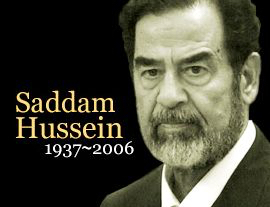F
sexymomo88 shared a photo from Flipboard
SADDAM HUSSEIN Saddam Hussein Abd al-Majid al-Tikriti was born in Tikrit, Iraq, on April 28th, 1937. At age 3 Saddam was sent to Baghdad to live with his uncle, Khairallah Talfah, a devout Sunni Muslim and ardent Arab nationalist. He attended the nationalistic al-Karh Secondary School in Baghdad, and in 1957, at age 20, Saddam joined the Ba'ath Party, whose ultimate ideological aim was the unity of Arab states in the Middle East. He was someone who believes that religion should be excluded from government and education. He rose through the Baath political party to assume a dictatorial presidency, Saddam Hussein was the president of Iraq for 24 years beginning on July 16th, 1979. He is seen as a figurehead of the country's military conflicts with Iran and the United States. In 1959 on October 7th Saddam and members of the Ba-ath Party attempted to assassinate Iraq's then-president, Abd al-Karim Qasim, Saddam got away from the assassination with a bullet in his leg, he then escape to Syria where he stayed briefly. Saddam then flee to Egypt where he attended law school. However in 1963, he return to Iraq after law school in Egypt when Qasim's government was overthrown in the so-called Ramadan Revolution, but he was arrested the following year as the result of in-fighting in the Ba'ath Party. While in prison Saddam remain involved in politics and in 1966 he was appointed deputy secretary of the Regional Command. Saddam in 1968 participated in a bloodless but successful Ba'athist coup that resulted in Ahmed Hassan al-Bakr becoming Iraq's president and Saddam his deputy. Within al-Bakr presidency Saddam prove to be a progressive and effective politician, he improve Iraq industry, and health-care system, and raised social services, education, and farming subsidies to levels that were not equal in other Arab countries in the region. He also nationalized Iraq's oil industry, just before the energy crisis of 1973, which resulted in massive revenues for the nation. During that time Saddam also helped develop Iraq's first chemical weapons program and, to guard against coups, created a powerful security equipment. In 1979 when Saddam became president Ayatollah Khomeini led a successful Islamic revolution in Iraq's neighbor to the northeast, Iran. Saddam became worried because his political power was rested in part upon the support of Iraq's minority Sunni population, he was worried that developments in Shi-ite majority Iran could lead to a similar uprising in Iraq. So on September 22, 1980, Saddam ordered Iraqi forces to invade the oil-rich region of Khuzestan in Iran. Even though the conflict became an all out war western nations and much of the Arab world, fearful of the spread of Islamic radicalism and what it would mean to the region and the world, laid their support firmly behind Saddam, despite the fact that his invasion of Iran clearly violated international law. On August 20, 1988, after years of conflict that left hundreds of thousands dead on both sides, a ceasefire agreement was finally reached. After the conflict, at the end of the 1980s Saddam turned his attention toward Iraq's wealthy neighbor, Kuwait. Because it was a historical part of Iraq, on August 2, 1990, Saddam ordered the invasion of Kuwait. A UN Security Council give Saddam and Iraq a dead line to leave Kuwait but they never leave. So a UN coalition force headed by the United States confronted Iraqi forces, and a mere six weeks later, had driven them from Kuwait. A ceasefire agreement was signed, the terms of which included Iraq dismantling its germ and chemical weapons programs. However In 1993, when Iraqi forces violated a no-fly zone imposed by the United Nations, the United States launched a damaging missile attack on Baghdad. But when they continue to violate the no-fly zone and use their weapons program more missile strikes takes place and never ended until February 2001. On September 11th 2001 the World Trade Center in New York City went under attack which resulted in killing many people. After the attack soviet intelligence relayed information to the U.S. government that indicated Iraq was planning further terrorist attacks against the United States. In 2002 after U.S. President George W. Bush name Iraq as part of his "Axis of Evil," The UN then went and inspect Iraq suspected weapon cite and didn't find any evidence. Despite the fact that they didn't find any evidence on March 20th 2003 a U.S.-led coalition invaded Iraq and on April 9th 2003 Baghdad lost the war and Saddam Escape and went into hiding. While in hiding Saddam made several audio recordings in which he denounced Iraq's invaders and called for resistance. Finally, on December 13, 2003, Saddam was found hiding in a small underground bunker near a farmhouse in ad-Dawr, near Tikrit. He remain on a U.S. base in Baghdad, until June 30th 2004 then he was headed over to the Iraqi Government to stand trial for crimes against humanity. On November 5th, 2006 Saddam was found guilty and sentenced to death. Then on December 30, 2006, at Camp Justice, an Iraqi base in Baghdad, Saddam was hanged, despite his request to be shot. He was buried in Al-Awja, his birthplace, on December 31, 2006. Saddam Hussein had 5 children, two sons and three daughters and of the five his two sons were killed in a gun battle while two of his daughters deflected to Jordan with their nine children.
This image was shared from Flipboard,
a fast, beautiful way to flip through the news, photos and updates your
friends are sharing on Facebook, Twitter, Flickr, Google+ and
Instagram.
Free Download!
App Store Badge
